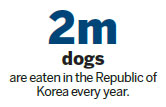Dog loses its bite with diners in ROK

For more than 30 years, chef and restaurant owner Oh Keum-il built her expertise in cooking one traditional Korean delicacy: dog meat.
While in her 20s, Oh traveled around the Republic of Korea to learn dog meat recipes from each region. During a period of ROK reconciliation with the Democratic People's Republic of Korea in the early 2000s, she went to Pyongyang as part of a business delegation and tasted a dozen different dog dishes, including dog stew and dog taffy, all served lavishly at the Koryo, one of the DPRK's best hotels.
She adapted famous dishes to include dog meat, replacing beef with dog in the ROK's signature meat and rice dish bibimbap.
But the 58-year-old's lifelong experience with a food eaten for centuries in Korea is about to become history.
Daegyo, the famous dog meat restaurant she opened in a Seoul alley in 1981, will serve its last bowl of boshintang, or dog stew, on Friday, a reflection of the challenges facing a trade that is neither legal nor explicitly banned under ROK laws governing livestock and food processing.
Opposite views on dogs as either for eating or petting have coexisted in the country's recent history, feeding a controversy that becomes most bitter in the summer. On three "dog days," which are among the hottest times of the year, many people in the ROK line up for the dish of shredded dog meat and vegetables in hot red soup, believing it provides strength to bear the heat.
Animal rights activists protest nearby, urging people not to eat "man's best friend". The closure of Oh's restaurant, dubbed by a local newspaper as the "Holy Land of boshintang" and known to be frequented by two former presidents, Lee Myung-bak and the late Roh Moo-hyun, shows one view of dogs is gaining more traction among young people in the ROK.
"There is too much a generational gap in boshintang," said Oh. "There are no young customers."
Dogs are also food in countries such as China and Vietnam. The long tradition of eating the meat in the ROK is such that a respected 17th-century book on Korean medicine extols its health benefits. But today it is an increasingly tough sell and a less-attractive dining option for young people in the ROK. Oh plans to reopen her restaurant as a Korean beef barbecue diner.
Animal rights groups have also highlighted that some of the 2 million or so dogs eaten in the ROK each year suffer painful and inhumane deaths.
Most young people eat chicken soup on a dog day, and even those who eat dog tend to refrain from talking about it openly, according to Moon Jaesuk, a 32-year researcher who enjoyed eating dog meat before he moved to Seoul.
"There's a burden in a group of 10 or 20 people to suggest eating dog, like making a sexual joke," he said. "It's not easy to talk about eating dog when there are a lot of people."
Young people in the ROK grow up watching TV shows about raising puppies and other pets, which sapped appetite for dog meat, said Oh.
Her restaurant used to sell as many as 700 bowls of dog stew a day in the 1980s. These days, it is less than half that. Young people also enjoy a diverse dining culture unlike previous generations that came of age amid the poverty that followed the 1950-53 Korean War.
(China Daily 08/29/2014 page10)












